Userflow for Customer Satisfaction: Features, Pricing, and Review

Looking for an effective customer satisfaction tool and wondering if Userflow is the best option for your SaaS company?
With numerous Userflow alternatives, it can be challenging to make a final decision.
In this article, we’ll delve into precisely that – helping you determine whether Userflow is the ideal choice for your Customer satisfaction needs. We’ll explore its features, pricing, and offer a comprehensive review to aid in your decision-making process.
Let’s get started!
TL;DR
- Userflow is a good choice for Customer satisfaction and it comes with features such as user journey mapping, self service support, in-app support, and Interactive user guides.
- There are a few instances where you’ll most likely need to look for an alternate solution instead of choosing Userflow as your user onboarding software:
- Analytics: If your product team or data analysts require advanced analytics that can be viewed on a single dashboard, then you’ll need to look elsewhere. Userflow’s analytics capabilities are limited and can only be viewed by diving into the settings of each flow/checklist/survey.
- Support: If your company favors live chat support over AI chatbots, then Userflow might not be the best choice. Userflow does have live chat integrations with tools like Intercom, Zendesk, and Freshchat, but it doesn’t have any native live chat capabilities.
- Bootstrap: If you’re bootstrapping a SaaS company, then it could be difficult to scale with Userflow as your onboarding solution. The limitations on the Startup plan mean that you’ll quickly need to upgrade to the Pro subscription which costs almost 3x as much at $680/month.
- If you’re looking for a better option for Customer satisfaction, Userpilot exceeds both functionality and value for money compared to Userflow. Ready to see Userpilot in action? Schedule a demo today to explore its powerful Customer satisfaction capabilities firsthand.
![]()
Looking for a Better Alternative for Customer Satisfaction? Try Userpilot

What is Userflow?
Userflow is a user onboarding solution centered around building in-app flows and guides quickly and seamlessly. It helps product teams onboard new users, creates guides/checklists, and surveys customers to gather valuable feedback.
Each flow has its own analytics that shows how many views each step of a funnel gets and what percentage of users end up seeing a particular stage. Lastly, the flow builder (Userflow’s main feature) also has versioning capabilities so you can restore your flows to a previous variant.
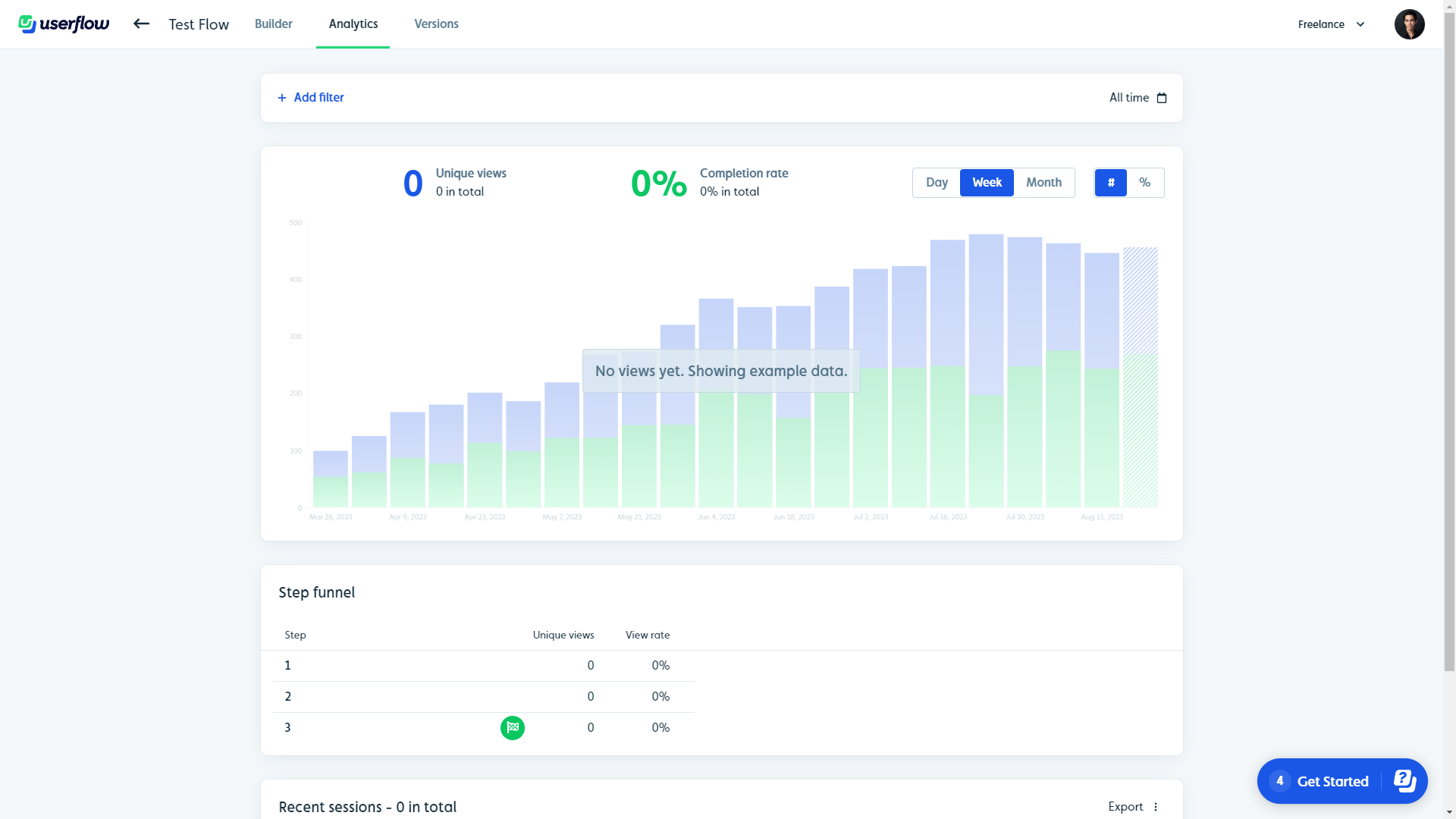
Must have features of customer satisfaction tools
When choosing a customer satisfaction tool, it’s important to consider its ability to measure satisfaction, predict loyalty, and provide insights. Let’s explore these top features:
- No-code in-app surveys: Short questionnaire surveys like NPS, CSAT, and CES to help measure customer loyalty, satisfaction level, and experience without coding.
- Product usage analytics: An indirect feedback feature to track user interactions and identify popular and overlooked features.
- Passive feedback: These are in-app feedback widgets at various interaction points, allowing customers to provide feedback voluntarily and on their terms.
- Self-help resource center: An intuitive self-service support that quickly guides users to solutions – reducing friction and providing timely assistance for a better user experience.
- Customizable survey templates: These enable you to adjust the survey design using themes, helping it blend in with your brand and ensuring that the feedback forms integrate seamlessly into your user interface.
- Localization: For a global reach, ensure the tool offers customization and translation for various languages.
- Time-based triggers: To capture feedback throughout the customer journey, opt for tools that trigger surveys based on specific time intervals and post-event interactions.
Userflow features for customer satisfaction
A good customer experience is imperative to lasting user retention. While Userflow’s lack of product analytics capabilities limits the customer experience insights it can offer, the software does let you add questions.
- Question blocks: Userflow lets you add question blocks to steps in the flow builder. Text-based questions are ideal for collecting qualitative feedback on the customer experience while scale or star ratings can be used to create CSAT or CES surveys within your no-code flows.
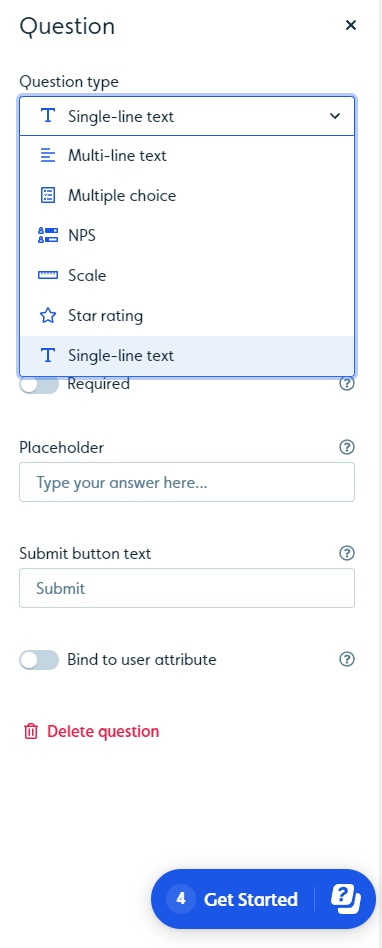
- NPS surveys: Userflow lets you create NPS surveys to see how satisfied users are with their customer experience and are loyal to your brand. Unfortunately, you’ll only be able to add two questions unless you upgrade to the Pro plan which starts at $680/month.
Note: Because Userflow has no unified analytics dashboard, you’ll need to go into the settings of each individual NPS survey to see data like total views, response rate, and the aggregate score from all respondents.

- Segmentation: Userflow lets you filter or target users by what language they speak, how much they spend on your product, how long ago they signed up, which features they’ve interacted with, and which segment they’re in so you can offer a personalized customer experience.
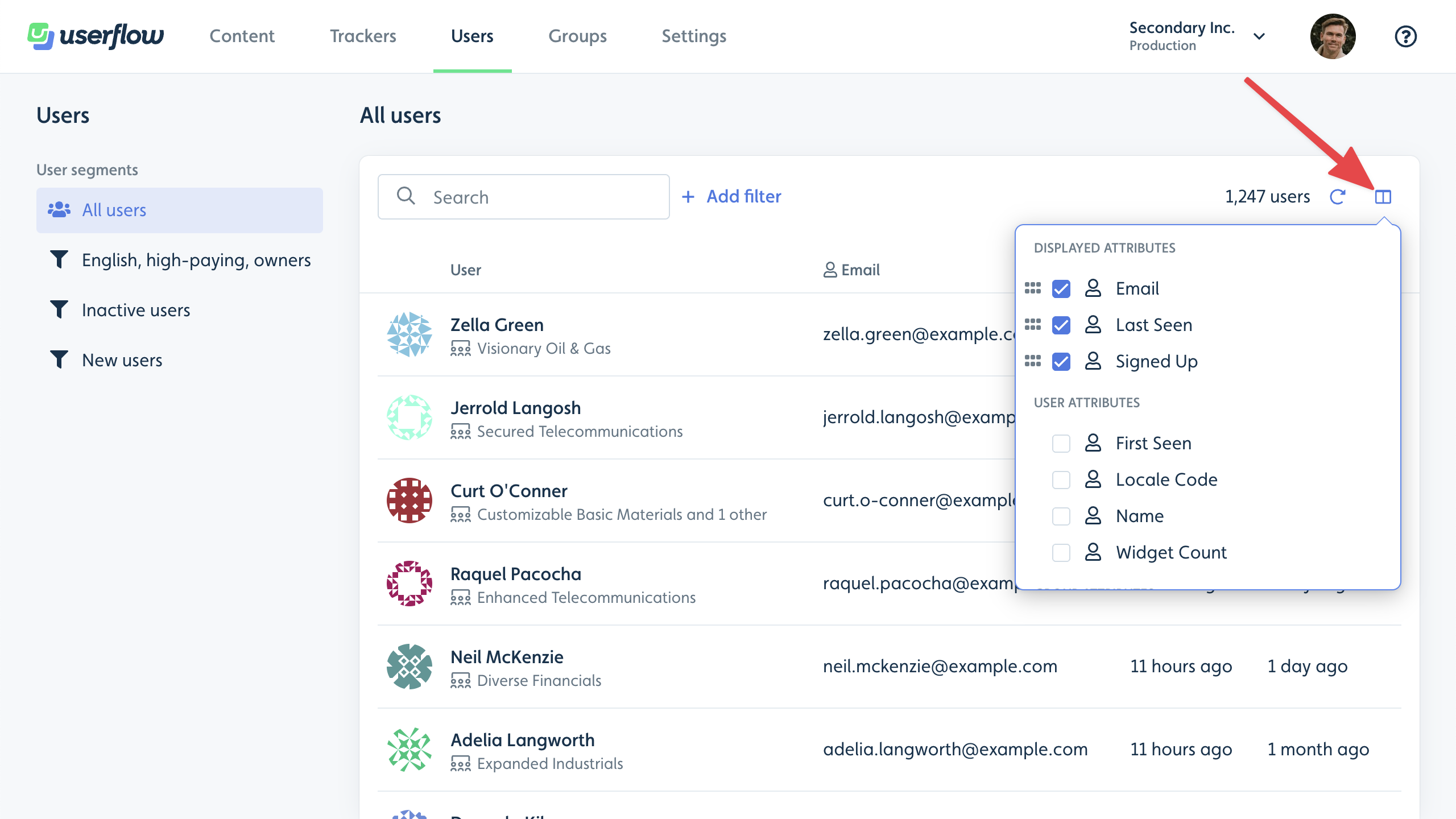
Userflow’s user journey mapping
A user journey map encompasses all interactions between customers and your product as they try to accomplish a task or goal. Unfortunately, Userflow doesn’t have any native features for user journey mapping.
You could look at which flows/checklists get the most interactions or sort users by which ones they’ve completed. However, the lack of a home analytics dashboard means you’ll need to look at each flow or checklist separately to find those with the most views and highest completion rates.
Userflow’s self service support
Self-service support decreases ticket volume and increases satisfaction levels. Userflow can aid self-service support through flows that teach users about a specific feature, checklists that guide them to their next step, and resource centers with documentation.
Here are the Userflow features you can use to build a self-service customer experience:
- In-app guides: Userflow lets you create in-app flows with tooltips, modals, and speech bubbles that guide users. You can even trigger flows whenever certain conditions are met, such as a user opening the resource center in the past hour while on a specific page.
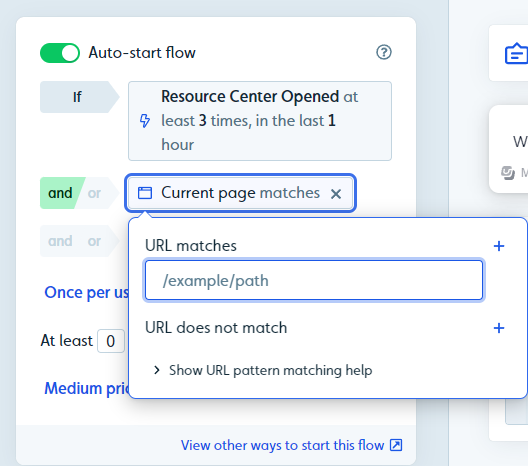
- Onboarding checklists: New users are the segment most likely to need support. Userflow lets you create onboarding checklists with unlimited tasks. You’ll also be able to use the completion of checklists as a condition to trigger in-app flows or show/hide certain resource center blocks.
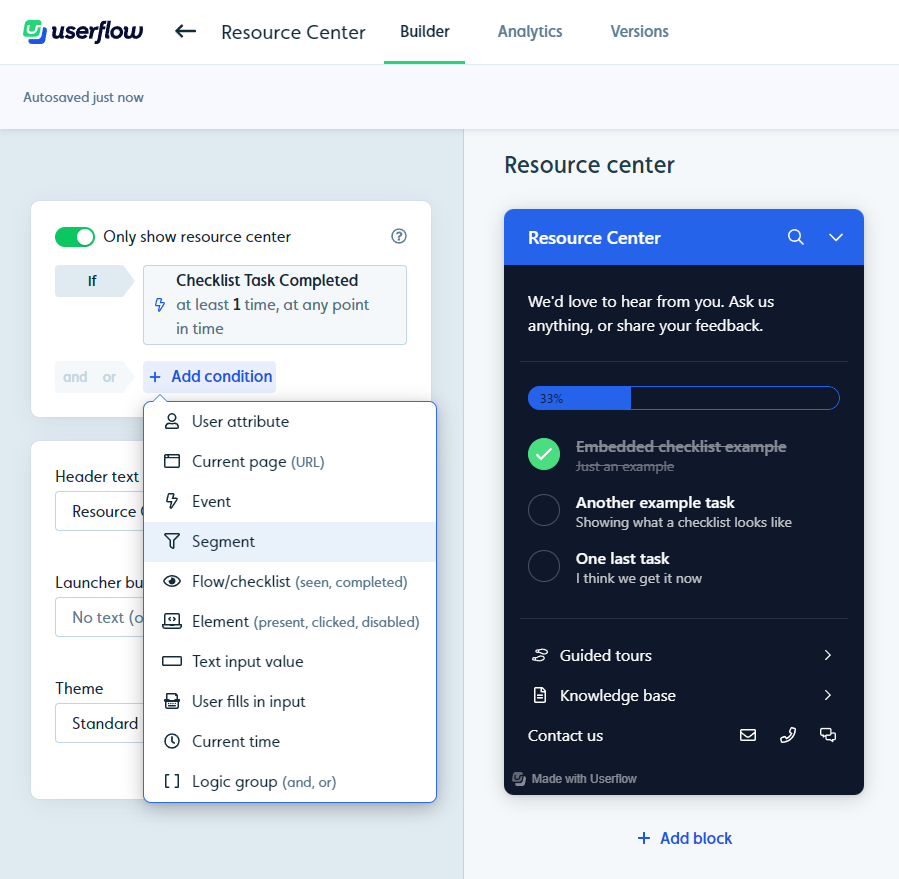
- Resource centers: Userflow in-app resource centers can include blocks like checklists, help articles, free-form content, checklists, announcements, and flow triggers. You can also style the resource center with custom themes or hide/show blocks when specific conditions are met.

- Live chats: You can leverage Userflow integrations like Crisp, Zendesk, Freshchat, Help Scout, HubSpot, or Intercom to give customers an option to connect to an actual human if self-service resources don’t solve their problem.
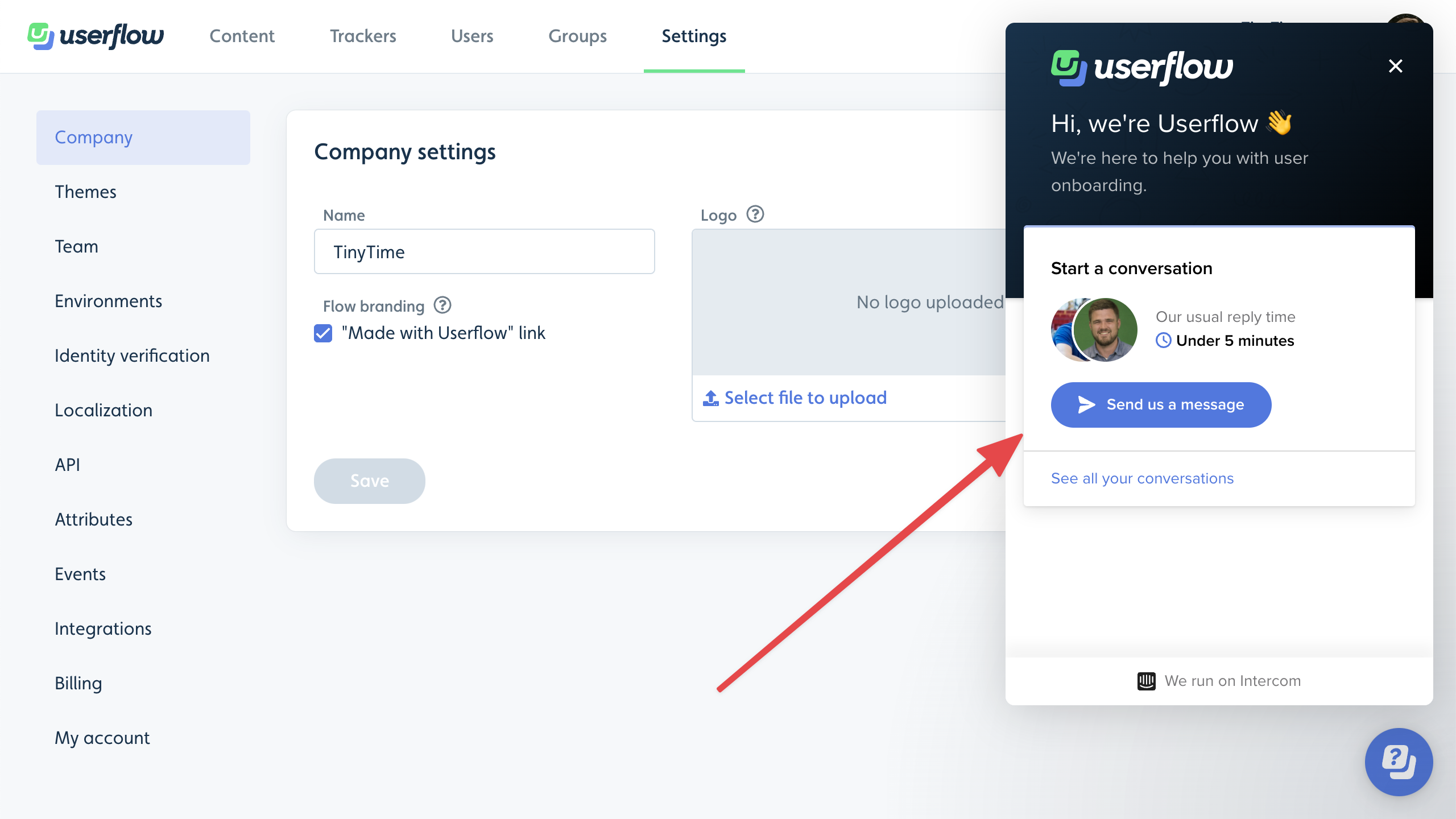
Userflow’s in-app support
In-app support provides assistance within the product so customers are left satisfied. Userflow is not positioned as a support tool but it does have resource centers, AI chatbots, and third-party integrations that can improve in-app support:
- Resource centers: Userflow resource centers can be segmented so they only show up to users who meet certain conditions. They can also be styled using custom header text, launcher buttons, or dark mode themes. You can also add blocks for actions, messages, sub-pages, flows, and AI chatbots.
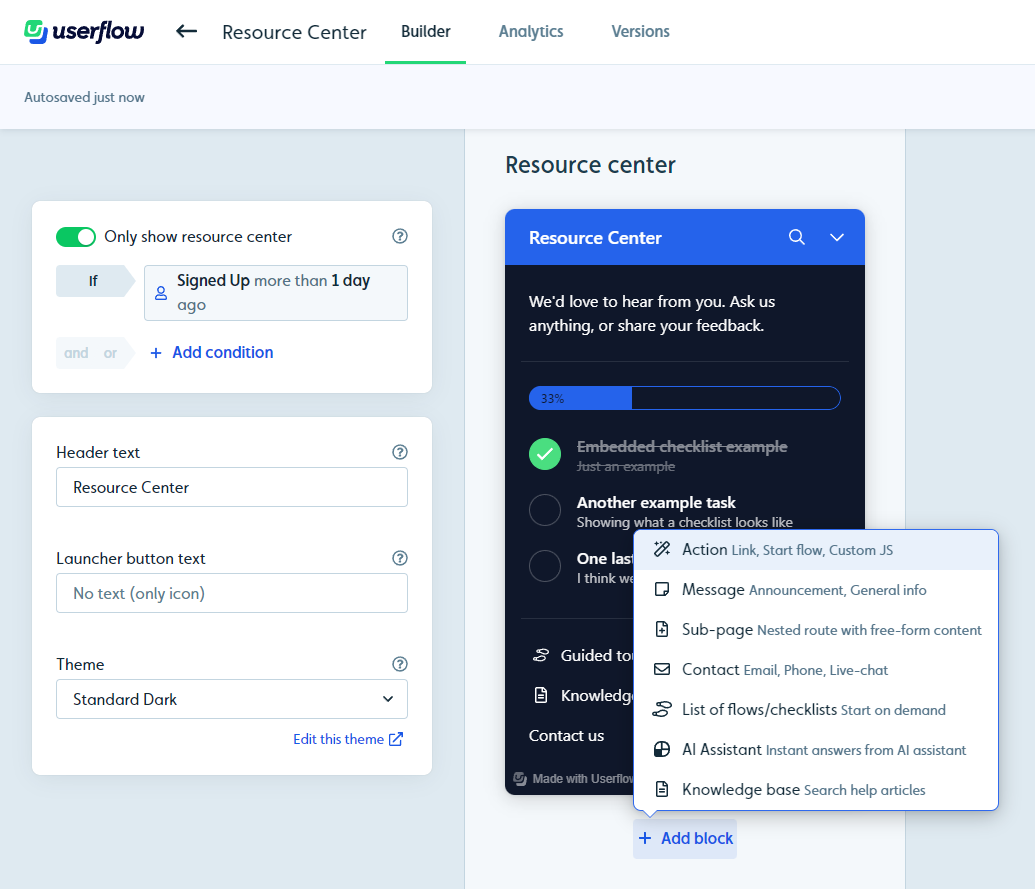
- AI assistants: Userflow’s AI assistants can be used to answer questions for customers while they wait for your human representatives. Do note that you’re limited to 100 messages per month and if you go over, you’ll be charged an additional $100/month for 500 message credits.
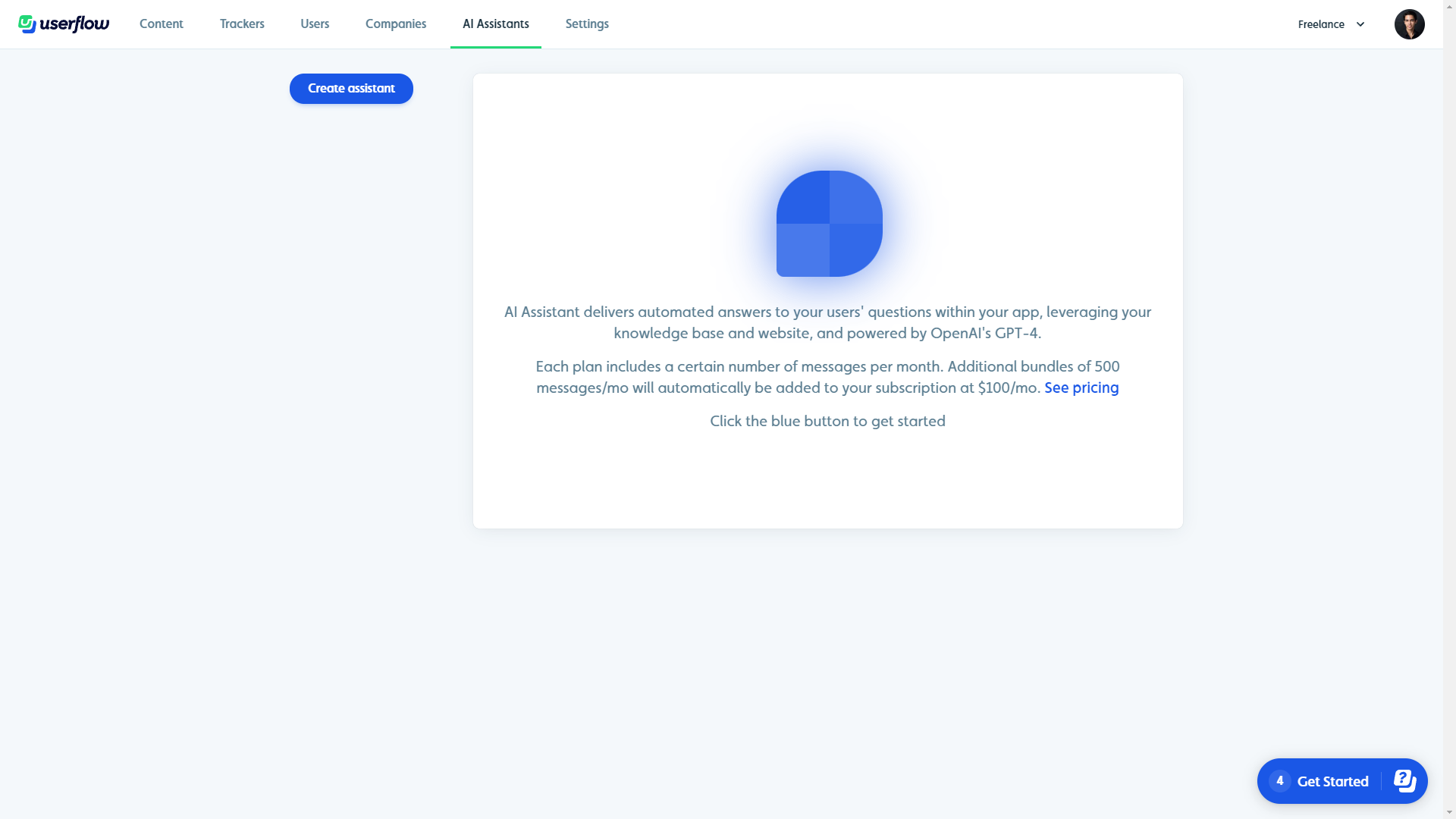
- Third-party integrations: Userflow has integrations with support tools like Intercom, Zendesk, and Freshchat. You can use these integrations to embed live chats in your resource centers or let your users search through external knowledge bases in-app.

Userflow’s Interactive user guides
Interactive user guides are various forms of in-app guides that help users learn how to use a product. These could include tooltips, hotspots, checklists, and other interactive UI elements that draw the user’s attention toward a specific button or feature.
Here are the Userflow features you can use to create and optimize interactive guides:
- Drag-and-drop editor: Userflow’s flow builder lets you create interactive user guides without writing any code. You can add steps like speech bubbles, tooltips, and modals. If you need hotspots, then simply click on “Add block” and select the “Beacon” option.
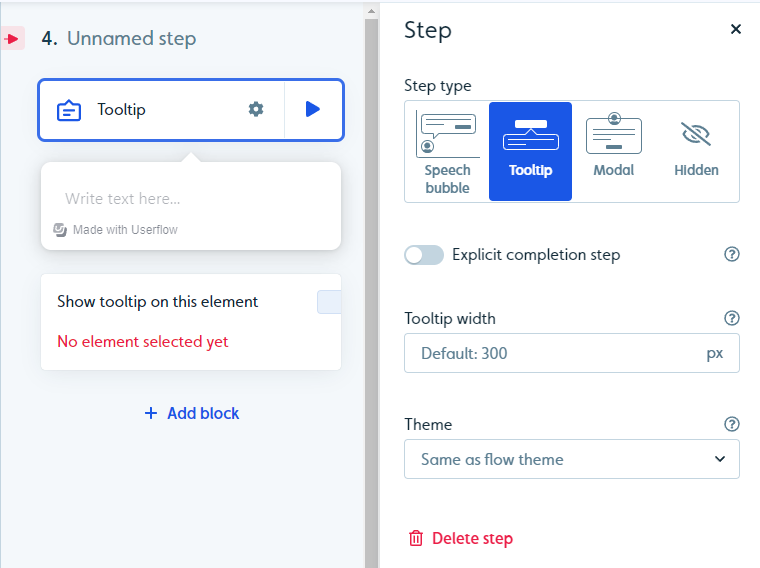
- Conditional triggers: Userflow lets you target segments or users with particular attributes by adding auto-start conditions to your interactive user guides. You can also use these conditions to hide guides from users based on when they signed up, which flows they’ve seen, and more.
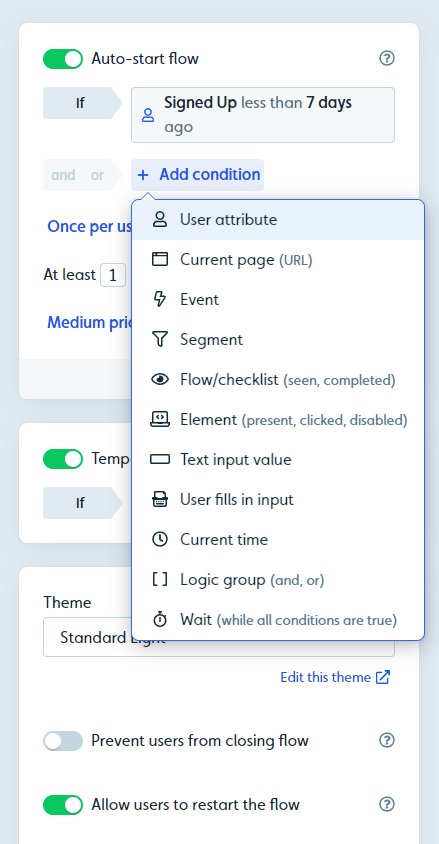
- Limitations: Users on the Basic plan can only create one resource center (making segmentation harder), and there’s no unified analytics dashboard, so you’ll need to check each flow separately.
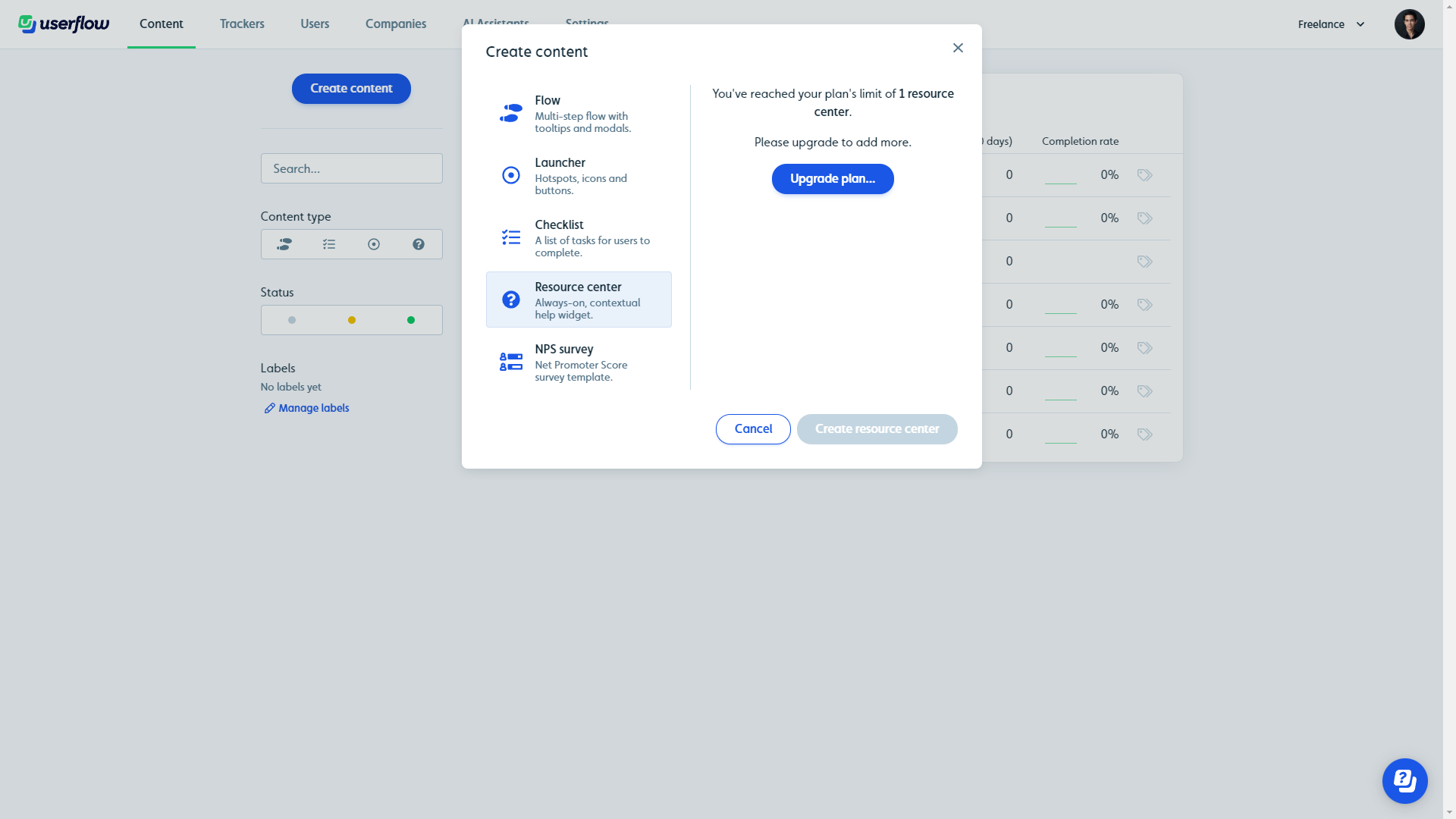
What are the pros and cons of Userflow?
Userflow’s pros
Userflow has multiple benefits but the most notable is how easy it is to create and edit flows within the software. Userflow’s ease-of-use makes it an attractive solution for product teams, marketers, and even solopreneurs.
Here are the pros of using Userflow:
- Flow builder: Userflow’s intuitive drag-and-drop flow builder makes it easy to add new steps, create links between steps, and reorder steps by moving them around. Speech bubbles, tooltips, and modals are the three primary UI elements that you can use when creating steps.
- AI assistant: Userflow lets you create in-app AI assistants that can respond to customers in their native language (but will default to English if unsure which language the customer is speaking). Do note that you’ll need to pay an additional $100/month if you exceed 100 monthly messages.
- Integrations: Userflow integrates with tools like Amplitude, Mixpanel, Segment, Salesforce, Heap, HubSpot, and more — which makes it easy to integrate Userflow with your existing tech stack so you can sync data between platforms.
Userflow’s cons
Of course, there are some limitations to Userflow since it’s one of the newer onboarding solutions on the market. Let’s take a look at some of the downsides of choosing Userflow as your onboarding tool:
- Analytics: This is undoubtedly Userflow’s biggest weakness. It doesn’t have a home dashboard for analytics which means you’ll need to manually go into every flow, checklist, launcher, or resource center to view the analytics for it.
Note: Competitors like Userpilot and Pendo include native analytics dashboards on their entry-level plans.
- Reordering: While reordering steps in a flow can be done in a drag-and-drop fashion, the links between steps aren’t automatically severed. This means you’ll need to manually remove cross-step links and reconnect the steps whenever you change their order which can be a hassle.
- Limitations: Userflow’s entry-level plan has restrictive limitations like only being able to include two questions in NPS surveys and needing to pay extra if you want to add more than three team members (while competitors on the market like Userpilot usually offer five seats or more).
What do users say about Userflow?
The general consensus from Userflow’s customers seems to be that the user experience and customer support are quite good, but the gradual price increases have made the tool a less attractive option overall.
This is reflected in reviews like this:
- “Great to create onboarding walk-throughs and explaining new features to customers
- Easy to use and manage without technical skills
- Unlimited locale support
- Hubspot integration
- Resource center”
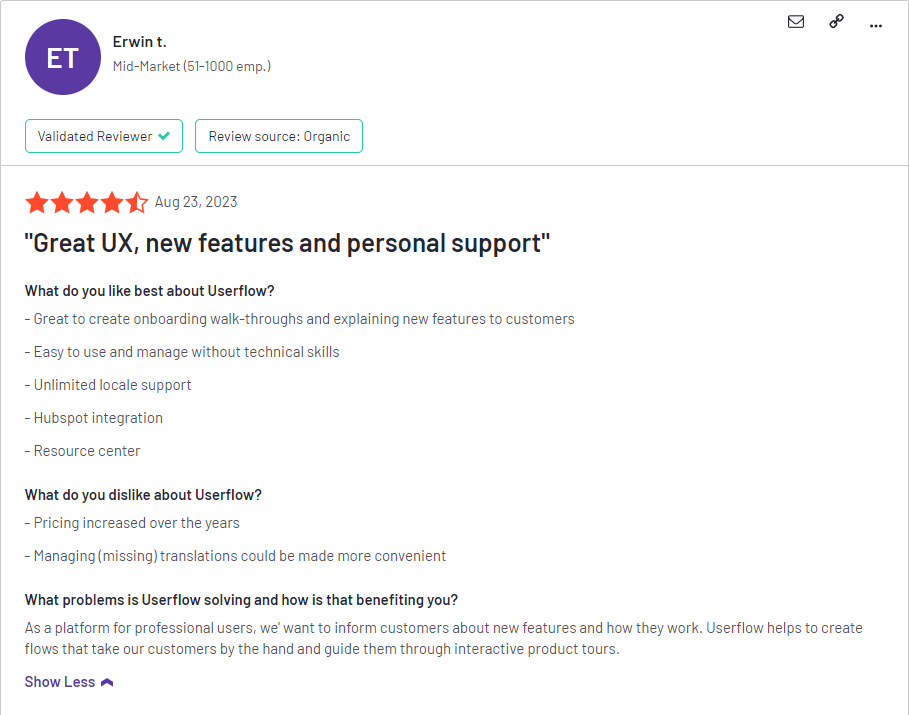 Of course, negative feedback isn’t limited to pricing as there are also customers who are dissatisfied with the product’s feature set and lack of interconnected dashboards:
Of course, negative feedback isn’t limited to pricing as there are also customers who are dissatisfied with the product’s feature set and lack of interconnected dashboards:
“I wish that we could better link things by creating projects where I could organize flows, launchers and CSATs that are all interconnected and related to the same thing.”
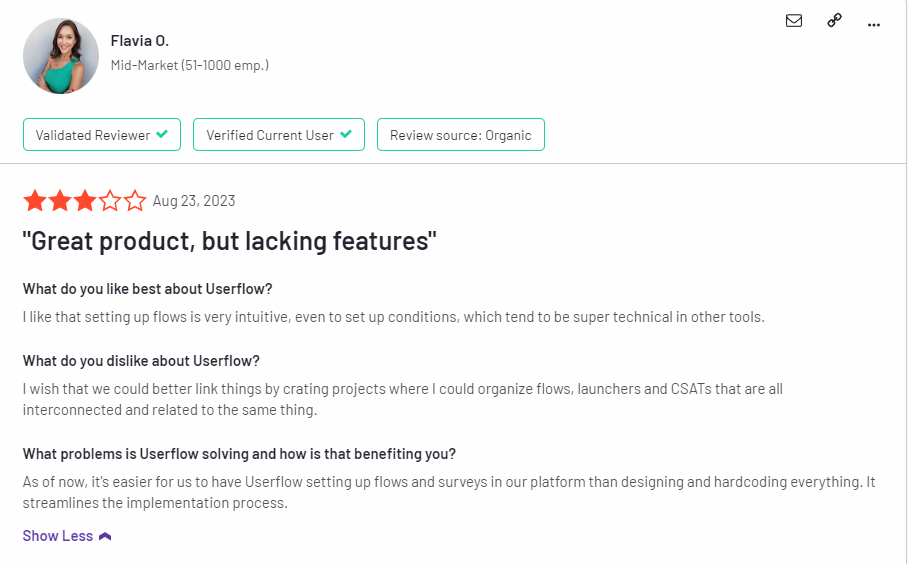
Userflow’s pricing
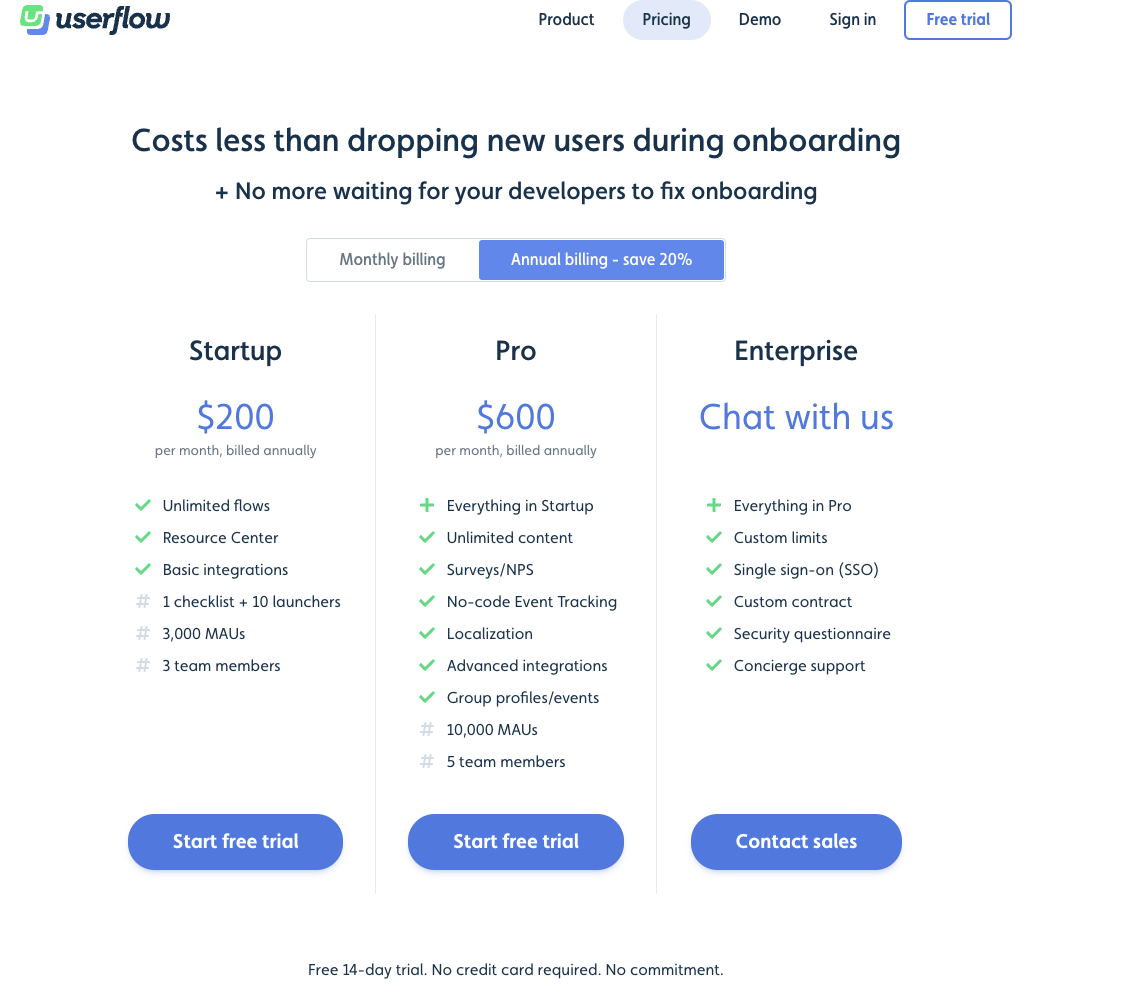
Userflow has three paid plans — Startup, Pro, and Enterprise — that start at $240 and increase in price as your MAUs grow. For example, the Startup plan costs over $1,000/month once you reach 50,000 MAUs which could make it difficult for products with thousands of freemium users to scale.
Here’s a closer look at each of Userflow’s plans:
- Startup: Userflow’s entry-level Startup plan starts at $240/month for 3,000 MAUs. Due to the survey and team size limitations of the Starter plan, you’ll likely need to upgrade to Pro at some point or purchase additional seats for $20/month each.
- Pro: Userflow’s Pro plan costs almost three times as much at $680/month for 10,000 MAUs. It contains essential features like localization, advanced integrations, event tracking, and unlimited surveys so you’ll probably need to upgrade to this tier eventually to continue growing.
- Enterprise: Userflow’s Enterprise tier is priced on a quote basis and can accommodate a custom number of MAUs. It comes with benefits like concierge support, security questionnaires, custom contracts, and single sign-on (SSO) features.
3 Reasons why you might need a Userflow alternative
There are a few instances where you’ll most likely need to look for an alternate solution instead of choosing Userflow as your user onboarding software:
- Analytics: If your product team or data analysts require advanced analytics that can be viewed on a single dashboard, then you’ll need to look elsewhere. Userflow’s analytics capabilities are limited and can only be viewed by diving into the settings of each flow/checklist/survey.
- Support: If your company favors live chat support over AI chatbots, then Userflow might not be the best choice. Userflow does have live chat integrations with tools like Intercom, Zendesk, and Freshchat, but it doesn’t have any native live chat capabilities.
- Bootstrap: If you’re bootstrapping a SaaS company, then it could be difficult to scale with Userflow as your onboarding solution. The limitations on the Startup plan mean that you’ll quickly need to upgrade to the Pro subscription which costs almost 3x as much at $680/month.
Userpilot – A better alternative for customer satisfaction
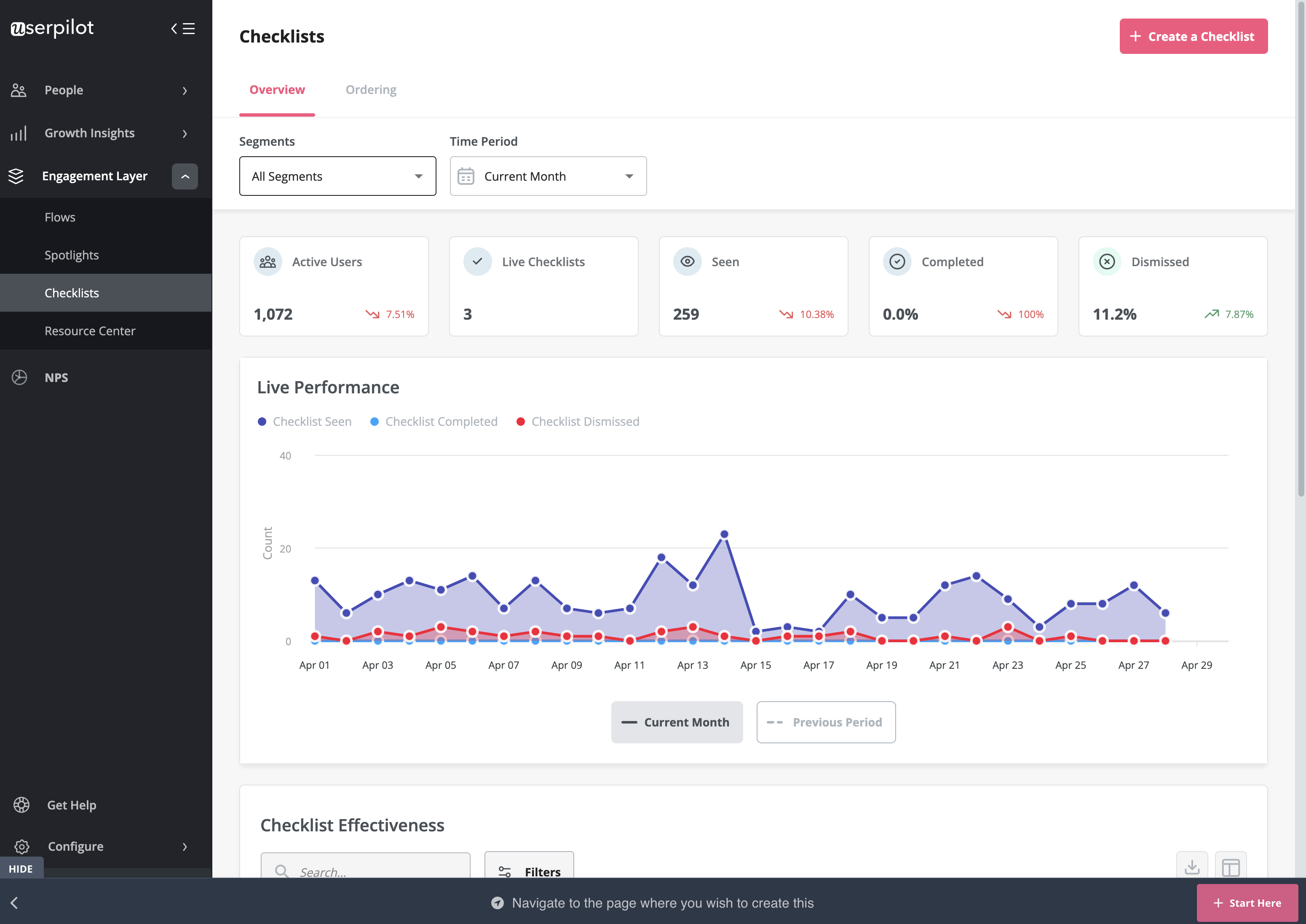 Userpilot gives you an eagle-eye view of the customer experience through user analytics, trend/funnel reports, and feedback collection through different types of surveys.
Userpilot gives you an eagle-eye view of the customer experience through user analytics, trend/funnel reports, and feedback collection through different types of surveys.
Here’s how you can use Userpilot to track and analyze customer experience insights:
- User analytics: The users dashboard gives you an overview of all your users while letting you sort by segment, company, or when they were last seen. You can also export user data in bulk as a CSV or click on the Insights tab to see segment-specific insights for a given time period.
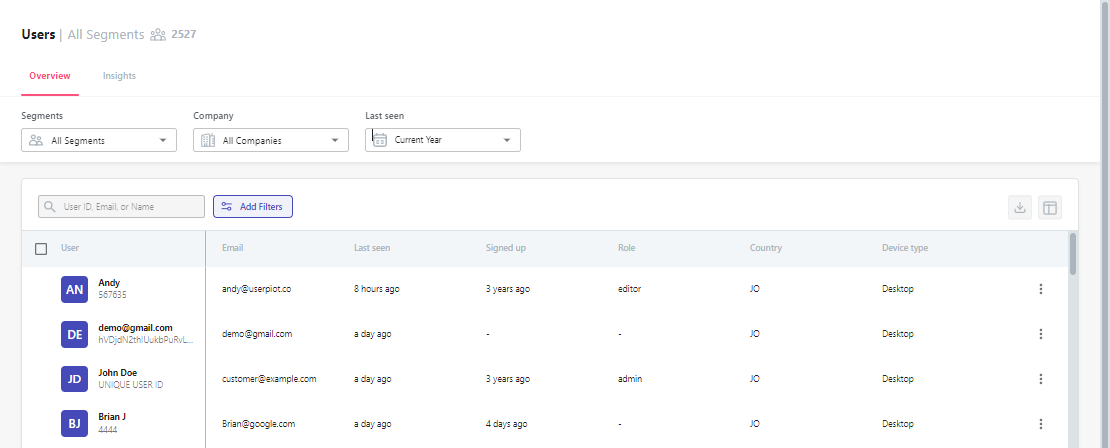
- Trends and funnels: Userpilot’s trends and funnels reports let you track certain events like a specific feature’s usage, add filters to narrow down the data, and then create a breakdown based on segmentation data or user attributes — offering quick and actionable CX reports.

- Satisfaction benchmarking: Userpilot has a built-in NPS dashboard that tracks customer loyalty over time. In addition to the NPS dashboard, you can also use Userpilot’s survey templates to run CSAT or CES surveys and gather additional quantitative and qualitative insights on the customer experience.
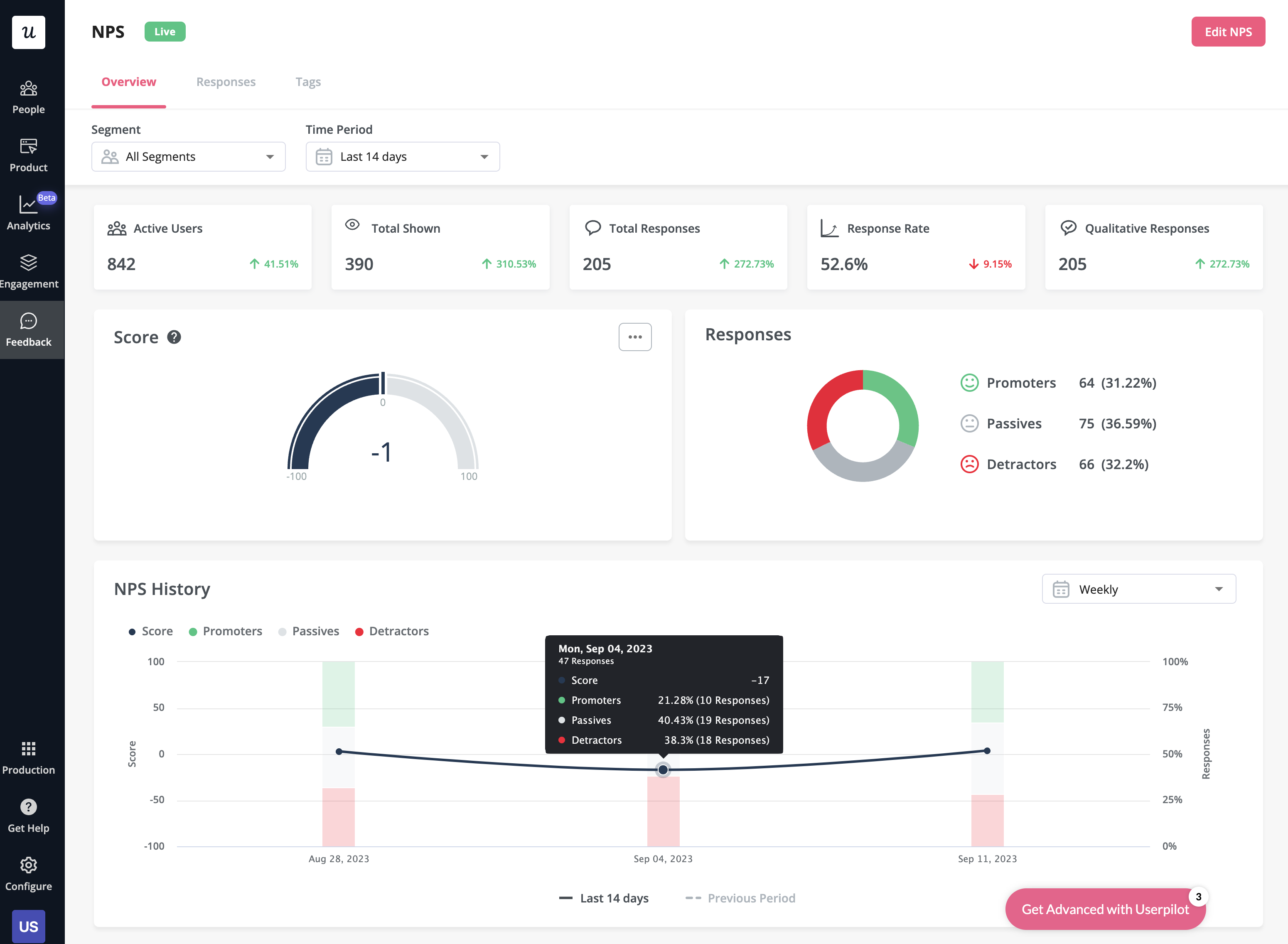
- Self-service support: Userpilot lets you build in-app resource centers, which can include feedback widgets to collect feedback passively, checklists to walk users through specific processes, or integrations with knowledge bases to leverage existing documentation.
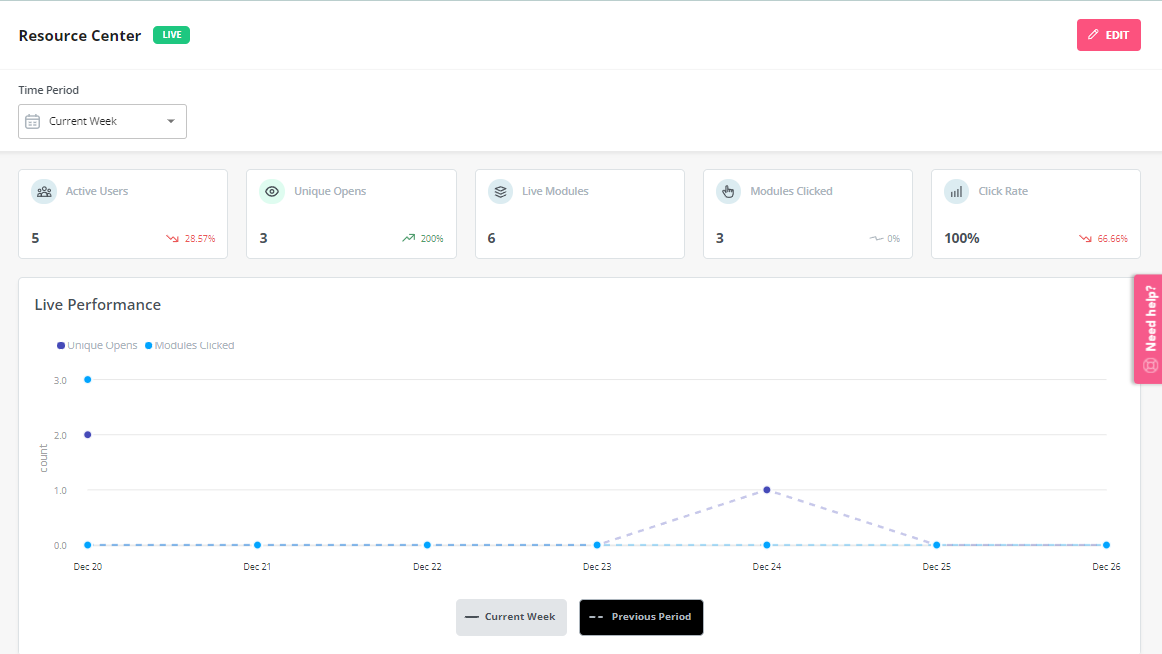
- In-app flows: Userpilot’s no-code flow builder helps you create product experiences that can help you optimize the customer experience by educating customers and reducing their time-to-value (TTV). All UI patterns are available on every Userpilot plan from Starter to Enterprise.
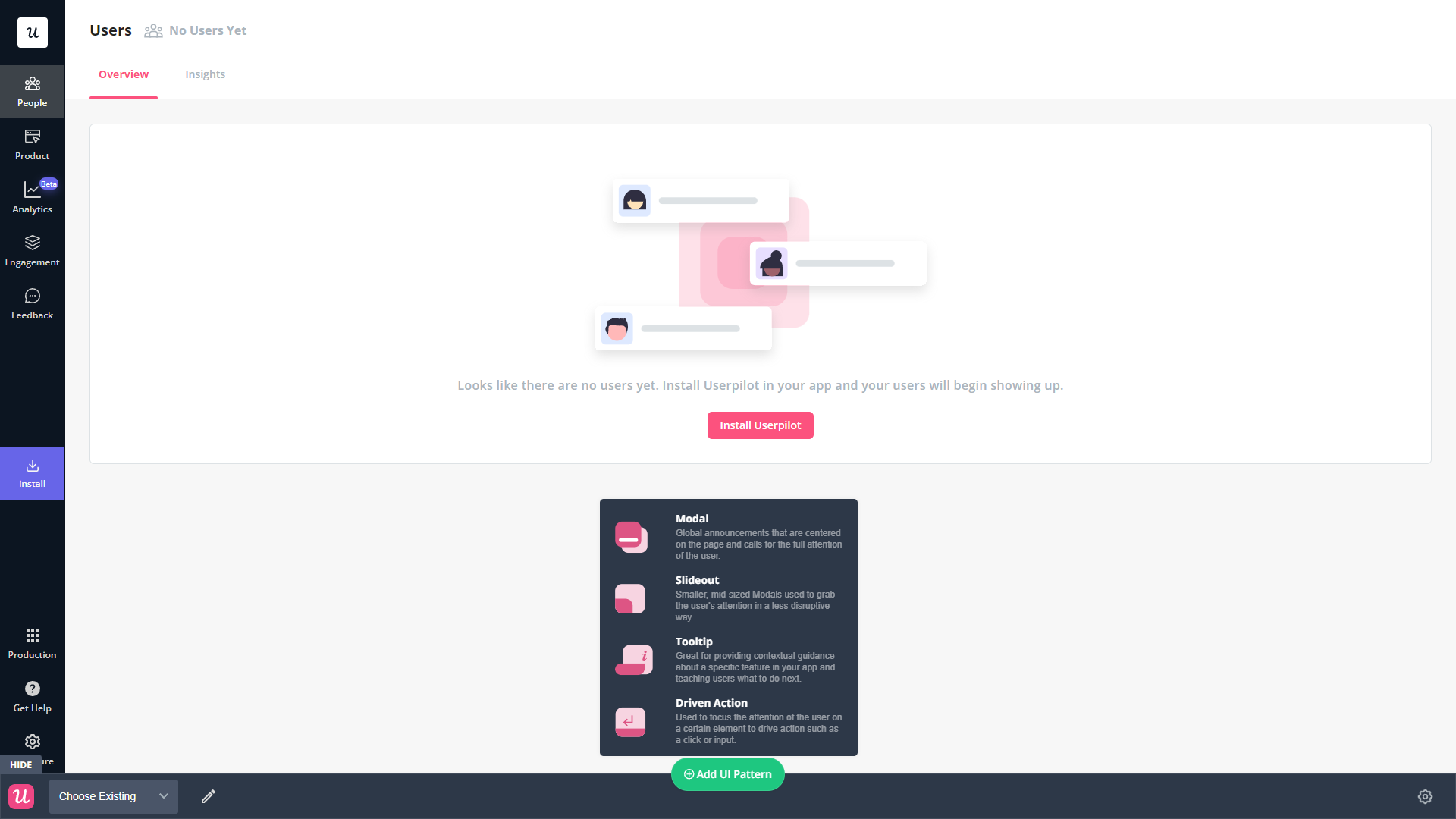
Userpilot’s user journey mapping
User journey mapping helps you visualize all the interactions between users and your product as they try to achieve a particular goal. Userpilot’s detailed user analytics and funnel/trend reports help you track customers as they progress through different stages of their journey.
Here are the Userpilot features you can use for user journey mapping:
- User analytics: The Users dashboard provides detailed analytics of your entire customer base. You’ll be able to sort by segment, company, or time period and add multiple filters to help you narrow results. You can also perform bulk actions and export user data in a CSV format.
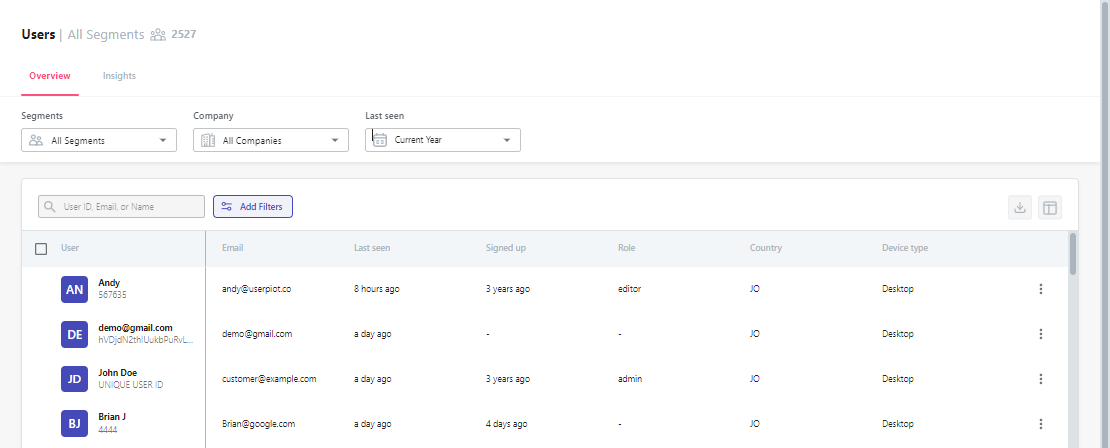
- Funnel reports: These reports help you visualize the user journey map by showing which stage, page, or action most users get stuck on. You’ll also be able to view breakdowns so you can see how the user journey changes depending on which OS, browser, or device type a user is on.
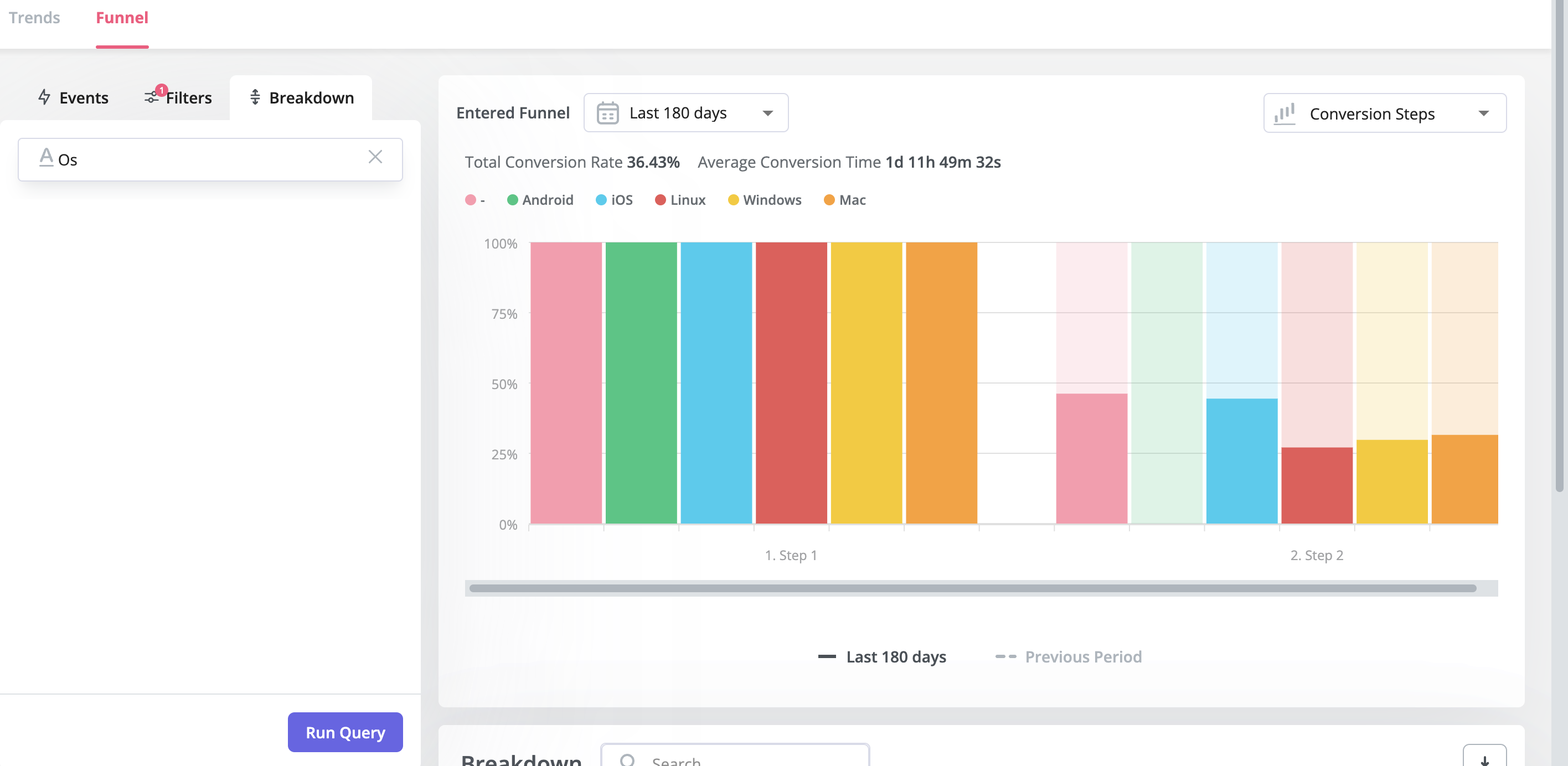
- Trend reports: Userpilot’s trend reports offer behavioral insights such as how often users perform a specific action, the number of unique users who take that action, and where in the user journey these actions occur. You can also create custom metrics and build your own charts.

Userpilot’s self service support
Self-service support helps users solve problems themselves instead of having to reach out to a representative. Userpilot’s no-code resource center makes onboarding guides and product documentation easily accessible to users from within your product.
Here’s how you can use Userpilot to create a self-service customer experience:
- No-code builder: Userpilot’s no-code resource center lets you add modules without writing a single line of code. Module options include links, videos, flows, custom JavaScript functions, and checklists. You can also group modules into sections to help users navigate the resource center.
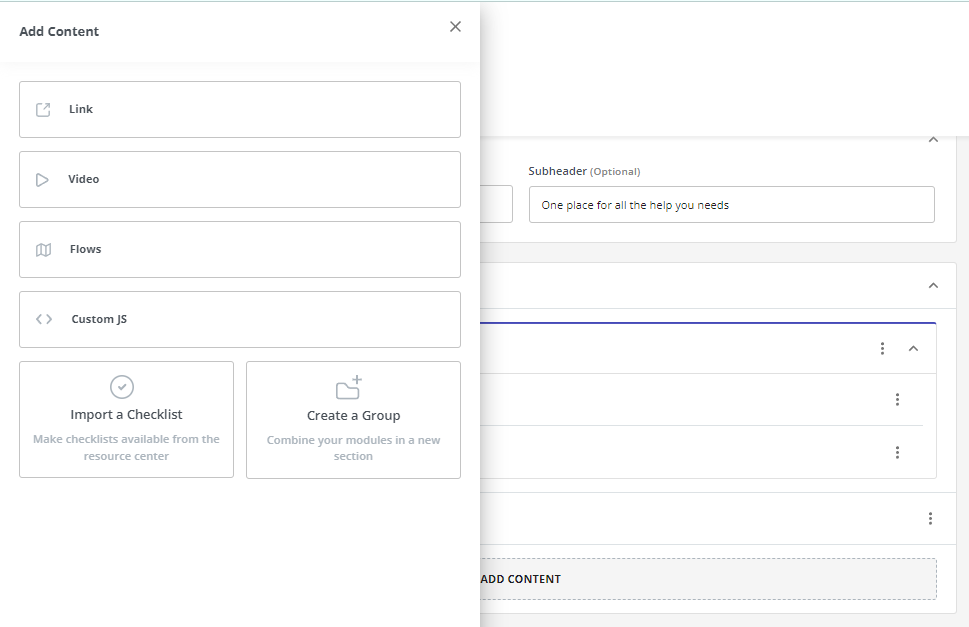
- Module segmentation: Userpilot’s segmentation settings let you hide or show specific modules within your resource center based on audience settings. This makes it possible to create modules for different user segments and hide resources that aren’t relevant to other users.
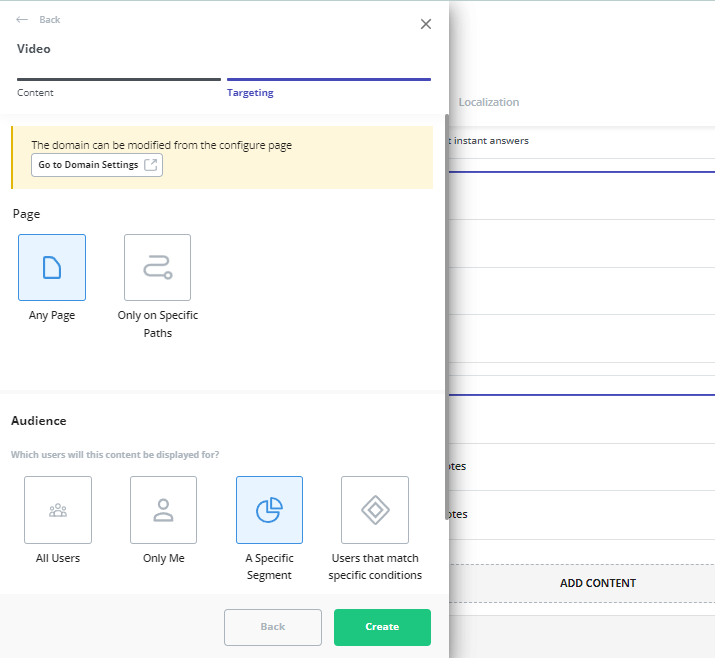
- Analytics dashboard: The dedicated analytics dashboard helps you see how many unique visitors your resource center gets, how many modules have been clicked, and the overall click rate across your user base. This will make it easier to gauge resource center performance.
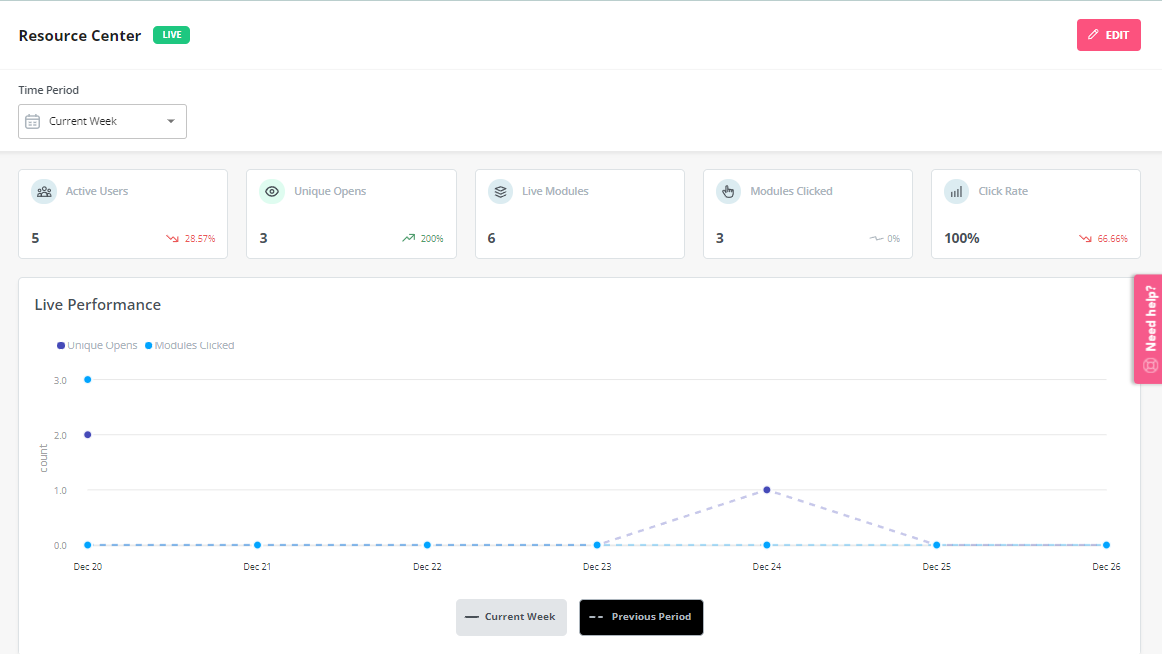
Userpilot’s in-app support
In-app support can increase customer satisfaction and retention rates. Userpilot has native in-app support features like resource centers and native tooltips as well as third-party integrations with popular support tools like Intercom to help you cover all your bases.
Here’s an overview of Userpilot’s in-app support capabilities:
- Resource center: Userpilot in-app resource centers let you add flows, checklists, external links, tutorial videos, external knowledge bases, and chatbots. You’ll also be able to view resource center analytics so you can check its performance.

- Native tooltips: In-app support must be proactive — which is why you should insert tooltips that guide users before they even think to open the resource center. Userpilot lets you add native tooltips that appear whenever users hover over an element or click on the info badge.
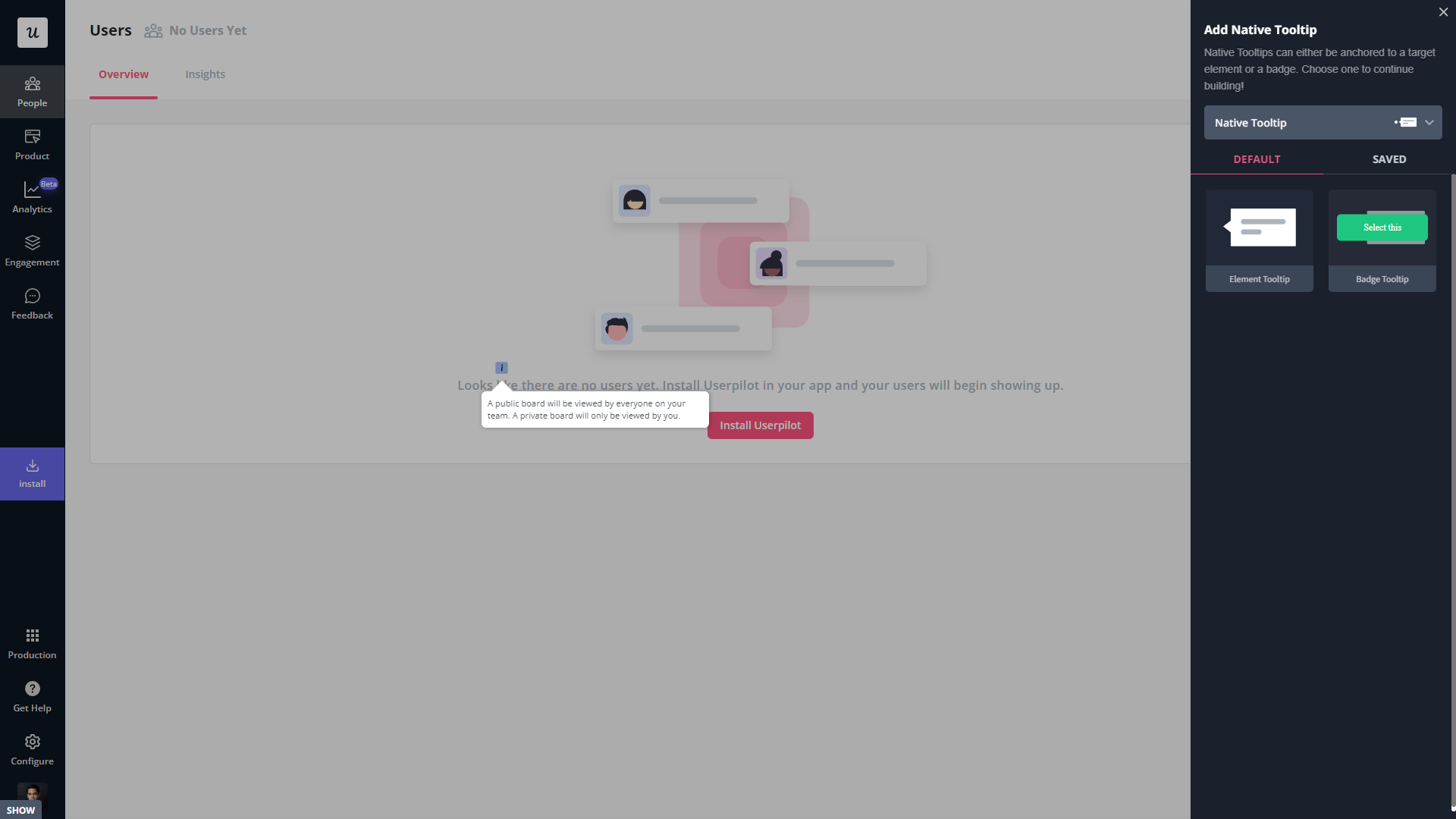
- Contextual flows: Userpilot’s trigger settings let you create contextual flows that automatically appear when a user reaches a certain page or performs a specific action. This can be used to offer in-app guidance and support whenever users try out a feature for the first time.
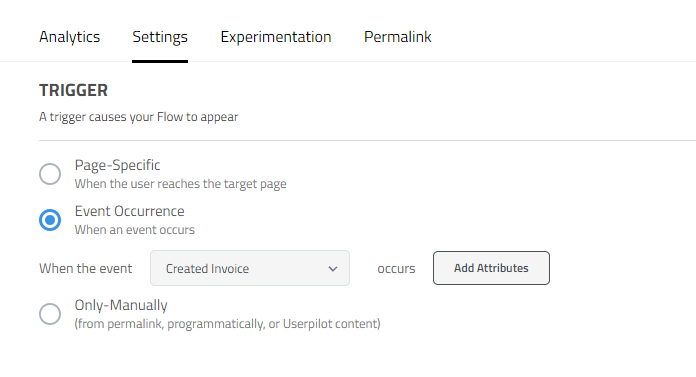
- Intercom integration: While Intercom is famous for its live chat embeds, you can do more than that by integrating it with Userpilot. You’ll see which events a user has done within Userpilot and whether or not they’ve completed onboarding to personalize support accordingly.
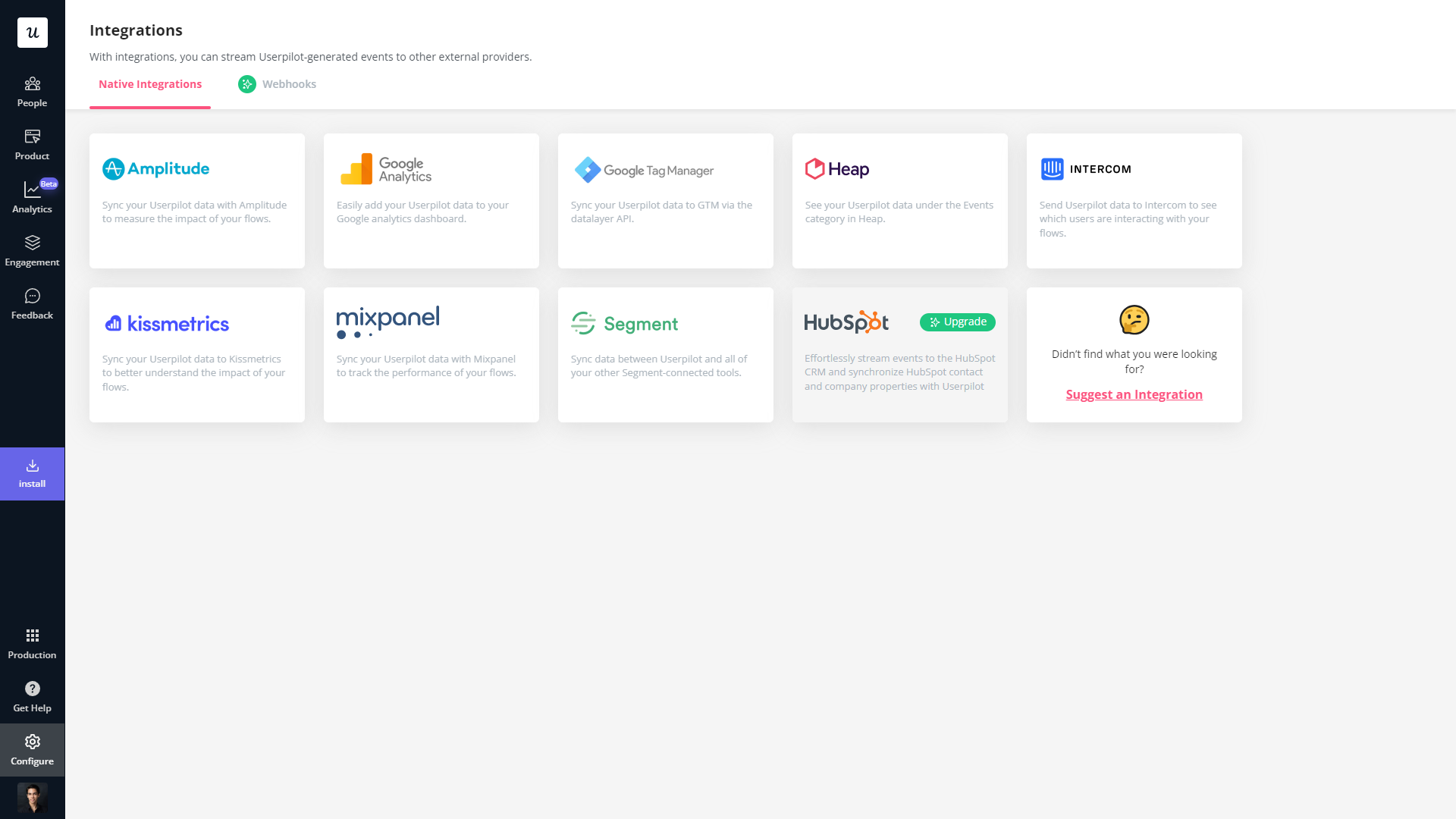
Userpilot’s Interactive user guides
Interactive user guides can help users figure out how to use your product and get them towards activation faster. Here are the Userpilot features you can use for creating interactive guides:
- No-code builder: Userpilot lets you build in-app guides using modals, slideouts, banners, etc., without writing any code. You can also tinker with audience settings to target specific segments or exclude users who meet certain conditions from seeing a particular flow.
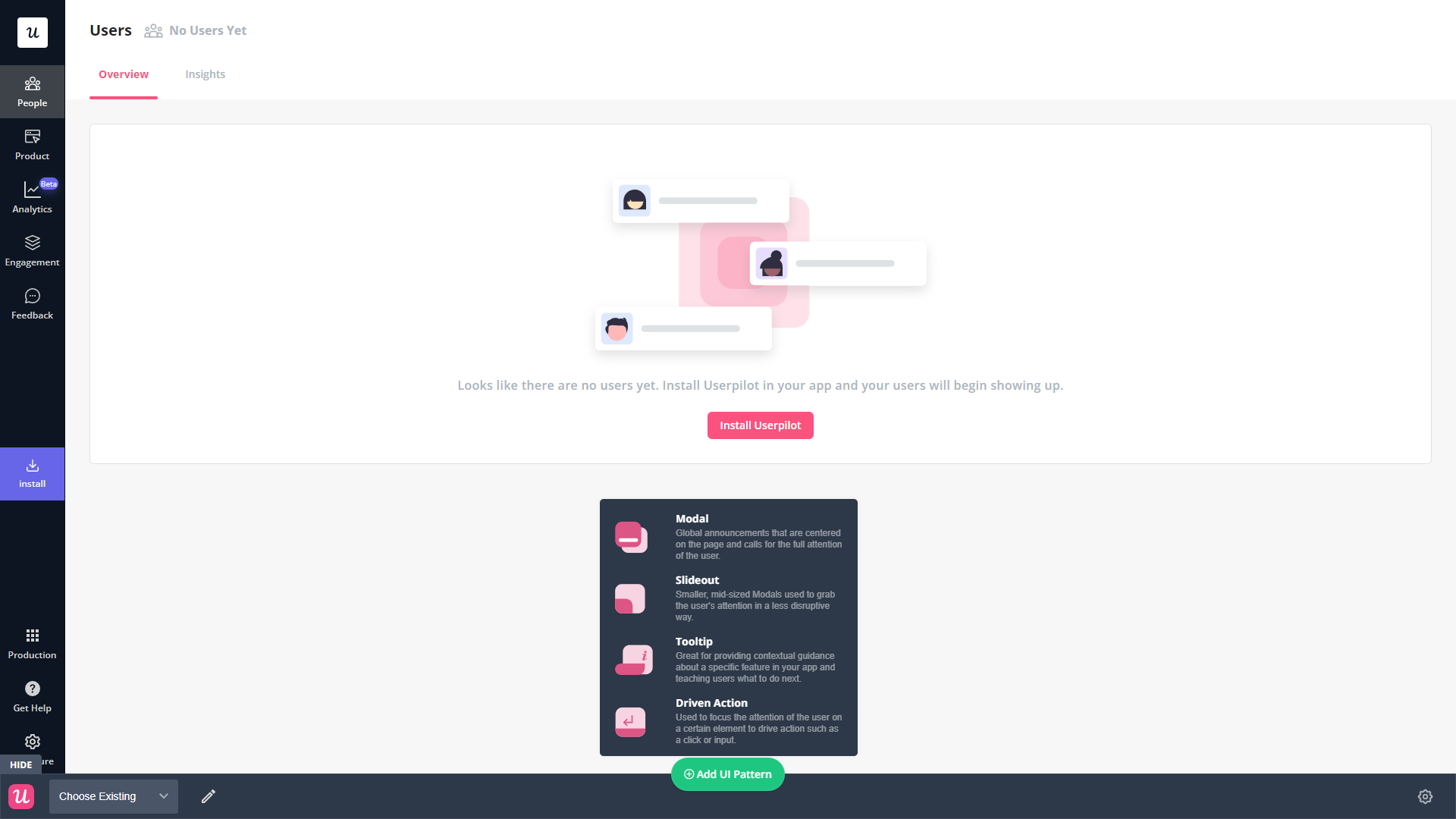
- Spotlight elements: The spotlight feature lets you add standalone UI elements like tooltips, hotspots, and driven actions that aren’t part of a multi-step flow. This makes it possible to display contextual guidance when users hover over a feature they’re interested in.
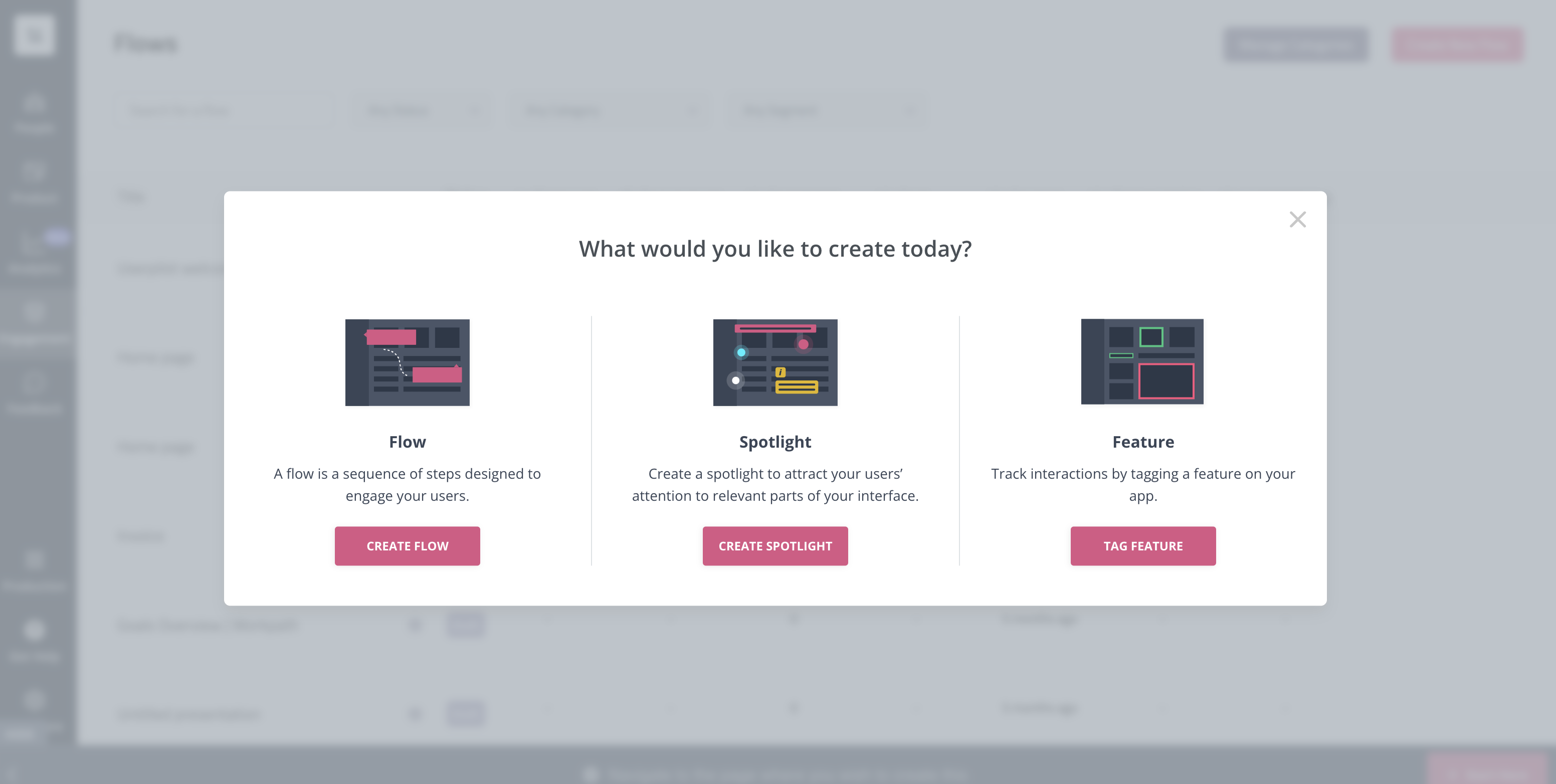
- Funnel reports: Userpilot’s advanced analytics capabilities include funnel reports that show you which pages or actions most users get stuck on. This can help you identify confusing or high-friction areas that can be removed through contextual interactive user guides.
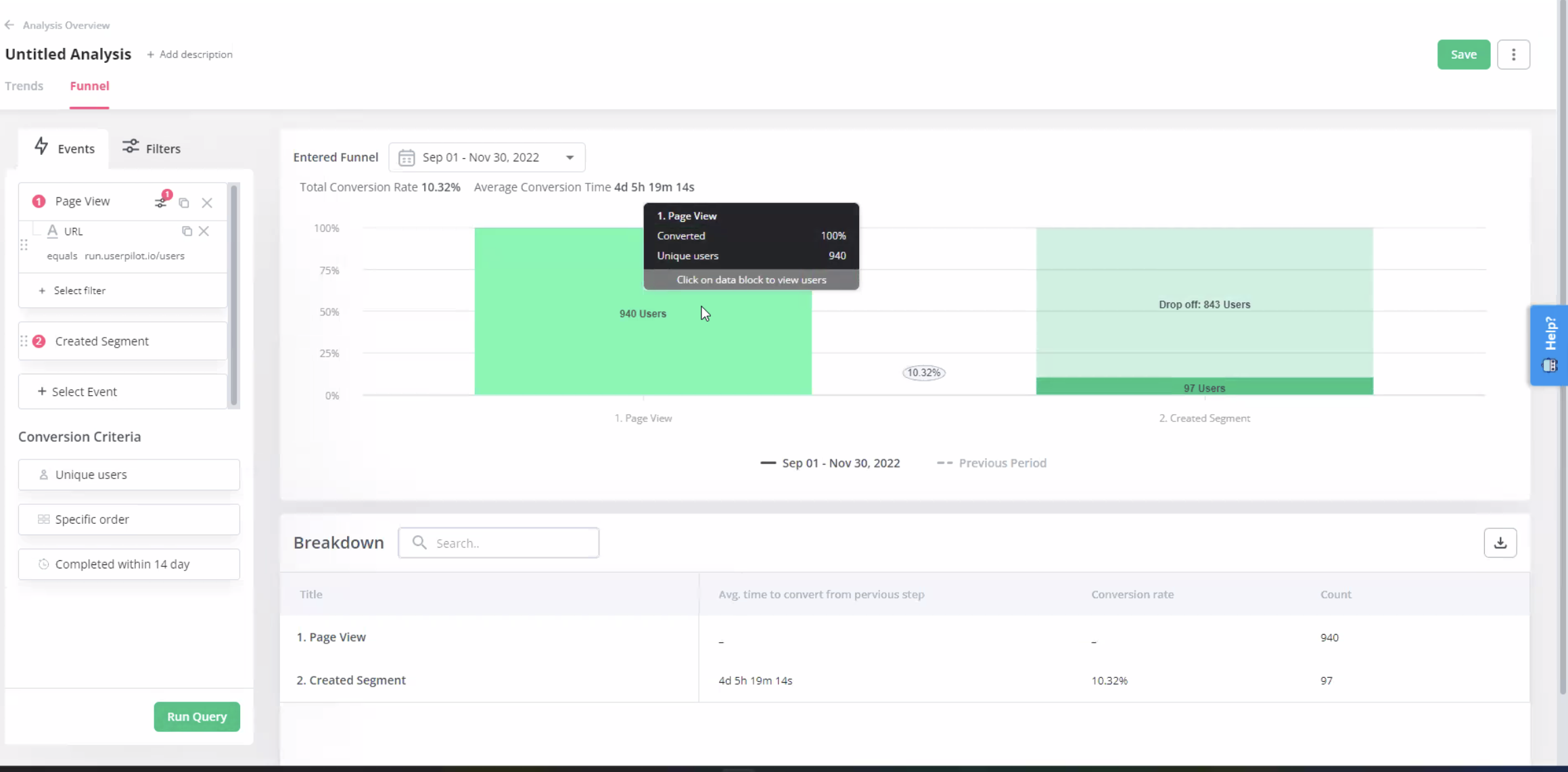
What are the pros and cons of Userpilot?
Userpilot pros
As a full-suite digital adoption platform, Userpilot has all the features you need to onboard users, track analytics, and gather feedback from customers without writing a single line of code. Here are a few pros of using Userpilot as your product growth solution:
- No-code builder: Userpilot’s Chrome extension lets you build flows, add UI elements, and tag features without writing a single line of code.
- UI patterns: There are plenty of UI patterns to choose from when using Userpilot, such as hotspots, tooltips, banners, slideouts, modals, and more!
- Startup-friendly: Userpilot’s entry-level plan gives you access to all available UI patterns so you can hit the ground running.
- Walkthroughs and flows: Build engaging interactive walkthroughs and personalized onboarding flows that target specific segments of your user base.
- Self-service support: Build an in-app resource center to help users solve problems, customize its appearance to align it with your brand, and insert various types of content (videos, flows, or chatbots) to keep your customers satisfied.
- A/B testing: Userpilot’s built-in A/B testing capabilities will help you split-test flows, iterate on the best-performing variants, and continually optimize based on user behavior.
- Feedback collection: Userpilot has built-in NPS surveys with its own unified analytics dashboard and response tagging to help you retarget users. There are other survey types to choose from and you can even create your own custom survey.
- Survey templates: There are 14 survey templates to choose from so you can gather feedback on specific features or run customer satisfaction benchmarking surveys like CSAT and CES.
- Advanced analytics: Userpilot lets you analyze product usage data, monitor engagement on all in-app flows, and use the data to create user segments that are based on behaviors instead of demographics.
- Event tracking: Userpilot’s no-code event tracking lets you tag UI interactions (hovers, clicks, or form fills) and group them into a custom event that reflects feature usage.
- Third-party integrations: Userpilot has built-in integrations with tools like Amplitude, Mixpanel, Kissmetrics, Segment, Heap, HubSpot, Intercom, Google Analytics, and Google Tag Manager so you can share data between all the solutions in your tech stack.
Userpilot’s cons
Of course, no tool is perfect and there are a few cons to consider before choosing Userpilot as your user onboarding or product growth solution:
- Employee onboarding: Currently, Userpilot only supports in-app customer onboarding.
- Mobile apps: Userpilot doesn’t have any mobile compatibility which could make it difficult for developers with cross-platform applications to create a consistent user experience for both versions of their product.
- Freemium plan: There’s no freemium Userpilot plan so those bootstrapping their startup and need sub-$100 solutions should consider more affordable onboarding platforms like UserGuiding or Product Fruits.
What do users say about Userpilot?
Most users laud Userpilot for its versatile feature set, ease of use, and responsive support team:
I recently had the pleasure of using Userpilot, and I must say it exceeded all my expectations. As a product manager, I’m always on the lookout for tools that can enhance user onboarding and improve overall user experience. Userpilot not only delivered on these fronts but also went above and beyond with its impressive new features, unparalleled ease of use, and truly exceptional customer support.
What truly sets Userpilot apart is its outstanding customer support. Throughout my journey with Userpilot, the support team has been responsive, knowledgeable, and genuinely dedicated to helping me succeed. Whenever I had a question or encountered an issue, their support team was always there to assist promptly, going above and beyond to ensure my concerns were addressed effectively.

Source: G2.
Of course, other users are also kind enough to share constructive criticism regarding specific features like event tracking filters:
“The filtration while analyzing specific events is a little confusing. Understanding of custom properties and data management configuration could have been more organised.”

Source: G2.
Userpilot’s pricing
Userpilot’s transparent pricing ranges from $249/month on the entry-level end to an Enterprise tier for larger companies.
Furthermore, Userpilot’s entry-level plan includes access to all UI patterns and should include everything that most mid-market SaaS businesses need to get started.

Userpilot has three paid plans to choose from:
- Starter: The entry-level Starter plan starts at $249/month and includes features like segmentation, product analytics, reporting, user engagement, user feedback, and customization.
- Growth: The Growth plan starts at $499/month and includes features like resource centers, advanced event-based triggers, unlimited feature tagging, AI-powered content localization, EU hosting options, and a dedicated customer success manager.
- Enterprise: The Enterprise plan uses custom pricing and includes all the features from Starter + Growth plus custom roles/permissions, access to premium integrations, priority support, custom contract, SLA, SAML SSO, activity logs, security audit and compliance (SOC 2/GDPR).
Conclusion
There you have it.
It should be easier now to make an informed decision whether Userflow is your go-to option for Customer satisfaction. Ultimately, the best choice will depend on your product and current needs.
If you’re looking for a better alternative to Userflow for Customer satisfaction, book a Userpilot demo today to experience firsthand how it can enhance your user experience and drive product growth!
![]()
Looking for a Better Alternative for Customer Satisfaction? Try Userpilot


